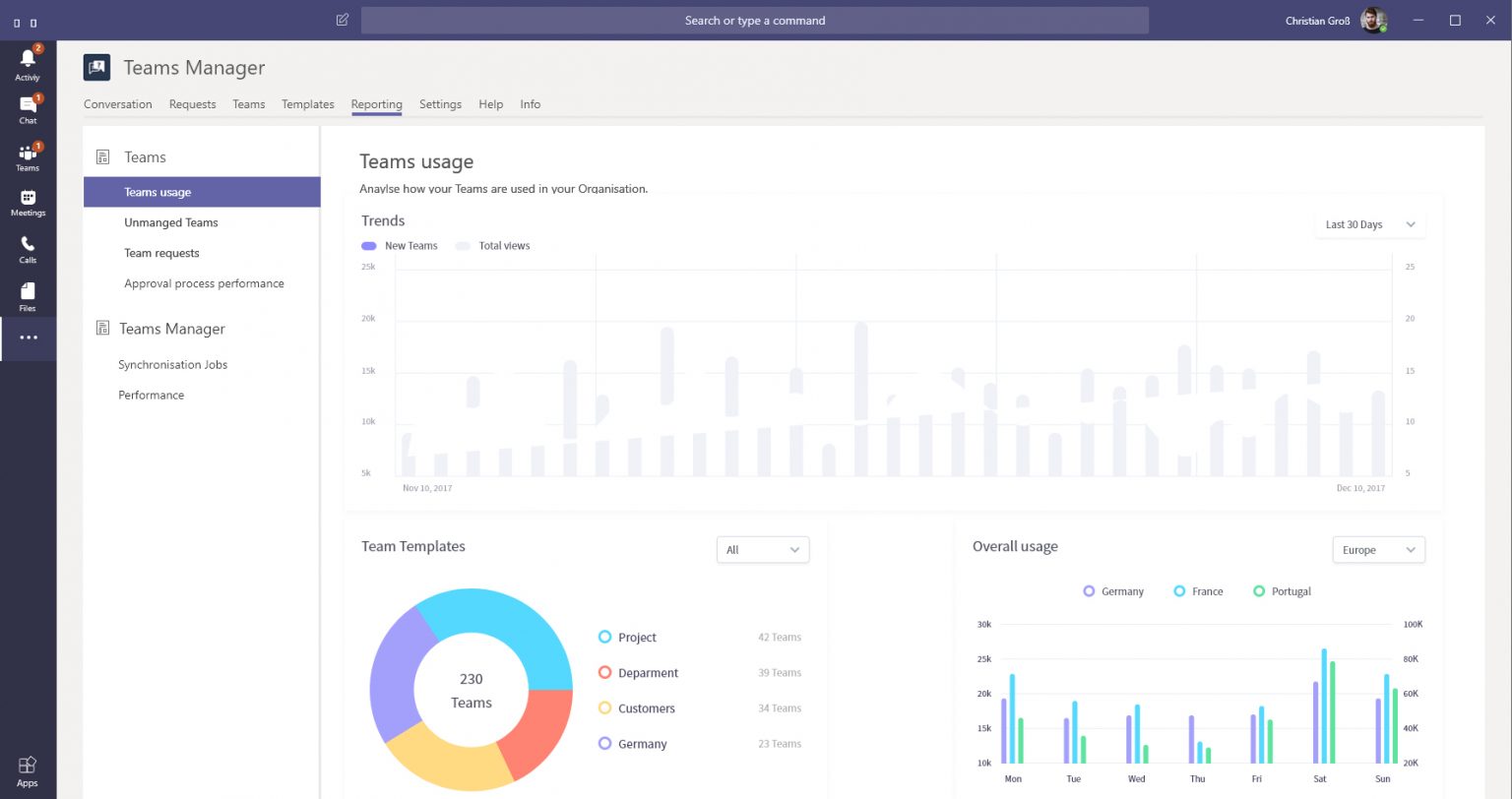Creating Teams in Microsoft Teams: Everybody or Nobody? (2025 Update)
One of the biggest problems with Microsoft Teams is the assumption that it can be effortlessly applied to large organisations and can be easily accepted and intuitively used by their users. However, this is a risky assumption to make when introducing Microsoft Teams into an organisation with mixed levels of confidence and competence, as there will be inconsistency in the use and creation of different Teams.
You’re not just deciding who gets to create new Teams. You’re deciding how fast the business can collaborate and how structured your tenant stays over time. The right answer balances speed with oversight.
Option 1, enabling your employees to create Teams themselves, increases acceptance. As your employees know best how a Team has to be structured for their task or project, this way saves unnecessary communication with the responsible administrator about the requirements and lowers the level of frustration.

Nevertheless, it can lead to problems if many employees have high permission levels and can create Teams themselves. Often it is not clearly defined when it is necessary to create a Team and when a channel or even just a chat is sufficient. It can also lead to Teams with the same purpose being created more than once. This way leads to uncontrolled growth that confuses your employees with too many Teams without any real benefit. Read here how to disable Microsoft Teams creation.
Option 2: We do not advise to completely prohibit your employees from creating Teams, because a long process of creating a Team through the IT department can lead to an interruption of the workflow. This can cause frustration among employees and administrators. Building barriers may seem like a sensible solution to controlling the flood of information associated with Microsoft Teams, but this can backfire if not managed carefully and appropriately.
In short: Letting everyone create new Teams increases adoption but risks duplication and sprawl. Letting nobody create Teams reduces chaos but slows the business and frustrates users. The best path is a controlled request-to-provision workflow with templates. This article compares both extremes and shows a pragmatic middle ground, including how a request flow works in practice.
For a meaningful use of Microsoft Teams in companies, this means that there are a few valid options to manage the uncontrolled growth of Teams:
- Creating teams is allowed for all employees. This can work in small businesses. However, training is recommended for employees, explaining to users how to use Microsoft Teams and when it is necessary to create a new Team. This can be time consuming and expensive.
- Only a few carefully selected users are allowed to create Teams. This would require that Team creation be disabled for everyone except a small group of power users located in different parts of the organization. This carries the risk of long mail conversations about requirements and disrupts the workflow.
- Another option would be to add an automatic approval workflow for creating teams. This gives your employees the ability to create Teams themselves and your company can still stay in control. There are several ways to implement this, but more about that later.
What happens when everybody can create Teams?
Upsides
- Fast onboarding of new workstreams and projects
- High adoption because users don’t have to wait
- True self-service culture
Downsides
- Duplicate Teams for the same purpose
- Inconsistent naming and incomplete setup
- Harder to find a specific Team; support tickets increase
- Inactive Teams due to users “just trying things out”
When it works
- Smaller companies or units with strong digital literacy
- Short-lived projects where speed outweighs structure

What happens when nobody can create Teams? (except IT admins)
Upsides
- Clear oversight over every new Team
- Less duplication; easier reporting and clean information architecture
- Better alignment to standards and templates
Downsides
- Bottlenecks in IT; longer wait times
- Shadow IT or workarounds in other tools
- Frustration for business units
- Low adoption rate
- Difficult to scale: more teams means more manual work
When it works
- Highly regulated environments with strict controls
- Scenarios with sensitive data and fixed processes
What is the practical answer for creating teams?
A controlled request-to-provision workflow gives you the best of both worlds: users request a Team, approvers evaluate the need, and approved requests are provisioned from templates. You get speed, control and consistency.

An approval workflow gives your employees enough freedom not to lose motivation and your IT administrators enough possibilities of intervention to stay in control. Especially in large companies it can be beneficial to use templates. On the one hand, it saves time, since tabs and channels etc. are already preconfigured, and on the other hand, the company can create specifications that are complied with for each template and thus for each Team created.
Decision helper: which solution fits your situation?
| Everybody can create new Teams | Nobody can create new Teams | Request-to-provision workflow | |
| Time-to-collaborate | 🟢 High | 🔴 Low | 🟢 High |
| Tenant hygiene | 🔴 Low | 🟢 High | 🟢 High |
| Effort for IT | 🟡 Low initially, high for clean-up | 🔴 High | 🟢 Low |
| User satisfaction | 🟡 High for creation, low for use | 🟡 Mixed | 🟢 High and sustained |
| Traceability (who/why, relevant for audits) | 🔴 Low | 🟢 High | 🟢 High |
How does a request-to-provision flow work?
1. Request
The user clicks “Request new Team” and fills a short form: name, business purpose, data sensitivity, requested owners.
2. Review
A defined approver checks against duplicates and purpose. If it’s a duplicate, the requester is pointed to the existing Team.
3. Provision
On approval, template-based provisioning creates the Team with standard channels, tabs, naming conventions, folder structure, documents, permissions etc.
This is where tools like Teams Manager shine for provisioning Teams and applying consistent setup.
4. Notify
The requester and owners receive a notification in Teams confirming the creation of the new Team.
5. Measure
Track requests and active Teams in a simple dashboard to improve the flow.
Looking for a step-by-step setup guide with policies and lifecycle?
See our separate articles on Private Channel Governance and broader Microsoft Teams governance topics.
No Code Provisioning of New Teams
If you are trying to avoid coding and the hassle that comes with it, or want to create Teams based on templates, a finished provisioning solution should be the right choice for you. In addition to fast implementation and easy handling, it gives you the opportunity to create your Teams based on templates. This saves a lot of time, since tabs and channels etc. are already preconfigured, and gives you the possibility to create specifications that are complied with for each template and thus for each Team created.
As a tool for this task, we recommend using the Teams Manager, which is capable of provisioning Teams based on templates including channels, settings, members, pre-defined tabs, Planner, OneNote and more. Changes in the template can easily be synchronized to all Teams based on the template.

Teams Manager is fully integrated into Microsoft Teams and built with user friendliness in mind. It also comes with additional governance features like archiving and deletion dates, a request list, highly customizable Teams templates, reports as well as an overview of all managed Teams.

Why does a template matter even more than approval?
Approval alone doesn’t prevent poor setup. Teams templates ensure each approved Team starts with the right structure from day one:
- Standard channels and tabs for your use case
- Predefined naming pattern and description
- Optional app tabs (Planner/Tasks, OneNote, SharePoint lists)
- Owners and members already defined (optional)
- Folders and subfolders for a consistent structure
Result: fewer “empty” Teams, less rework, faster time to value.
Example: request-to-provision with Teams Manager
- Request form captures purpose, department, sensitivity, owners and additional customizable metadata.
- Approval workflow routes to the right approvers (e.g. IT or business).
- Template-based provisioning applies structure automatically.
- Activity and request history support audits and capacity planning.
- All of this happens entirely within Microsoft Teams.

Which signals show that your current model isn’t working?
There are several warning signs that your current model for creating new teams is not working any more:
- Multiple Teams with the same or similar names for one project
- Users ask, “Which Team should I use?”
- IT cannot answer, “Who asked for this Team and when?”
- Owners are missing or inactive
- Inactive Teams start to pile up
- IT spends more and more time manually creating new Teams
A request-to-provision workflow solves these by capturing intent, preventing duplicates, and standardizing setup.
Minimal change playbook (start small, prove value)
- Introduce a lightweight request form for new Teams.
- Assign one approver group per business area.
- Publish one good template for the top use case (e.g., project delivery).
- Measure basic KPIs: time-to-approval, duplicates avoided, template adoption.
- Iterate with feedback from requesters and approvers.
FAQ about controlling Teams creation
Yes. An short request form for end users feels no different than creating teams by themselves. Approvers can then check for duplicates.
No. Start with one high-impact template (projects or customer work). Add more only when you see a clear pattern. In our experience, three to four templates are sufficient for most organizations.
Not if the flow is directly integrated in Microsoft Teams – users will not even notice they are not creating a new team by themselves. Most organizations value getting a well-structured space over instant, unstructured creation.
Use a consistent naming convention that is strictly enforced for all new teams. At best, it should be automated.

Next steps
- Map your top 3 use cases for new Teams.
- Launch a request-to-provision workflow.
- Add template-based provisioning and simple reporting.
If you want to operationalize fast, use Teams Manager for approval workflow and provisioning at scale. You will also save time with automated archiving of inactive Teams and gain more structure with automated naming rules.
Would you like to see a request-to-provision flow in action?
Book a free personal demo and get a template you can use right away.

Chief Commercial Officer and Governance Specialist at Solutions2Share
Florian Pflanz has more than 8 years of experience with Microsoft 365 and has supported over 250 workshops on Teams governance.
His focus lies on lifecycle management, provisioning, and compliance requirements in regulated industries.
He shares best practices with IT admins and decision-makers to reduce complexity and strengthen secure collaboration in Teams.





